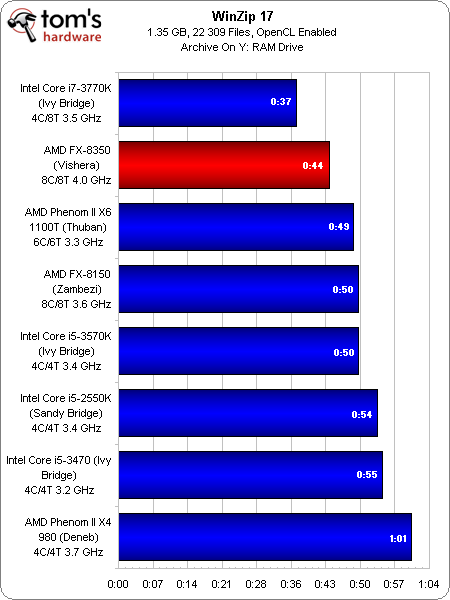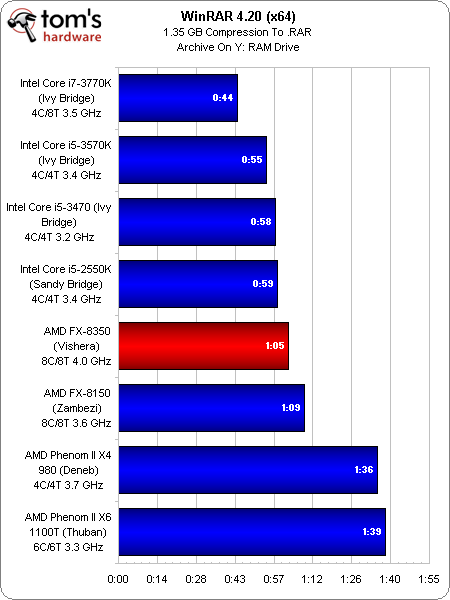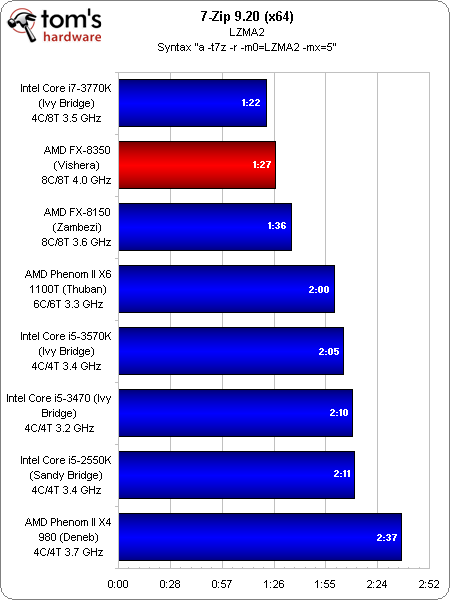AMD FX-8350 Review: Does Piledriver Fix Bulldozer's Flaws?
Last year, AMD launched its Bulldozer architecture to disappointed enthusiasts who were hoping to see the company rise to its former glory. Today, we get an FX processor based on the Piledriver update. Does it give power users something to celebrate?
Benchmark Results: Compression Apps
Corel just introduced WinZip 17, and we’re finally satisfied with the application’s ability to fully tax multiple cores simultaneously. The latest version of WinZip supports OpenCL-based acceleration on AMD, Intel, and Nvidia hardware, and we enabled the feature throughout testing. This is only applied to files larger than 8 MB, though. Our test folder contains thousands of files, and there aren’t many larger than 8 MB. So, it makes very little difference whether we run our benchmark with or without OpenCL support turned on.
Regardless, in a massive shift from last year when we tested the FX-8150 under WinZip 14 and it placed dead-last, the FX-8350 finishes in second place. The FX-8150 takes fourth—and against a more capable field, no less.
AMD would likely point at our test and rightly note that an increasing number of performance-sensitive applications are moving this direction—they’re either able to exploit multiple x86 cores simultaneously or leverage graphics resources. This gives the company’s hardware a growing advantage. But we remain concerned about the power it draws while it’s delivering marginally better benchmark results. More on that soon.
In light of WinZip’s rise to prominence once again, WinRAR looks like it’s now the least-able to exploit on-die resources. Sure, it sees plenty of speed-up from Intel’s efficient Ivy Bridge architecture. And the fact that an FX-8350 edges out an FX-8150 suggests those extra 400 MHz are going to use. But the new chip’s fifth-place finish is a tell-tale sign that the hardware is underutilized.
The outcome in 7-Zip isn’t too far off from WinZip 17. The Core i7-3770K does very well, but is followed closely by the FX-8350. AMD’s FX-8150 isn’t far behind that.
It’s almost surprising to see a Phenom II X6 take fourth place, but when you consider the four quad-core parts bringing up the back of the pack, it becomes clearer that 7-Zip has an affinity for cores, even if it takes of six of AMD’s Stars-based cores to beat four of Intel’s.
Get Tom's Hardware's best news and in-depth reviews, straight to your inbox.
Current page: Benchmark Results: Compression Apps
Prev Page Benchmark Results: Productivity Next Page Benchmark Results: Media Encoding-
amuffin Looks like AMD did pretty well with the 8350.Reply
I now really don't see people purchasing it though....people will be buying the 8320. -
kracker Interesting, nice improvement over BD, it spars very closely or beats the i5-3570K sometimes, It really can't compete with intel's high end, but nevertheless good job AMD!Reply -
sixdegree AMD is doing good with the pricing this time. This is what AMD should be: aggressively priced CPU with added features.Reply -
esrever The price is actually nice this time. Hopefully AMD sticks around and gives good deals like this for years to come.Reply -
Nice job AMD. It just kept itself afloat! Not performance killer, but good enough to get a chunk of desktop sales just in time for the holiday season. Probably wouldn't buy it over an Intel system because most apps are still quite single threaded, but I would certainly consider it. Welcome back to the race AMD. Keep up the good work!Reply
-
najirion so... amd will still keep my local electric provider happy. Good job AMD but I think FM2 APUs are more promising. The fact that APUs alone can win against intel processors if discrete graphics is not involved. Perhaps AMD should focus in their APU line like integrating better gpus in those apus that will allow dual 7xxx graphics and not just dual 6xxx hybrid graphics. The entire FX architecture seems to have the issue with its high power consumption and poor single-thread performance. Better move on AMD...Reply -
dscudella I would have liked to see more Intel offerings in the Benchmarks. Say an i3-2120 & i3-3220 for comparisons sake as they'll be cheaper than the new Piledrivers.Reply
If more games / daily use apps start using more cores these new AMD's could really take off. -
EzioAs Interesting. Probably not a gamers first choice but for users who regularly use multi-threaded programs, the 8350 should be very compelling. About $30 cheaper than a 3570K and can be overclock as well, video/photo editors should really consider this. It doesn't beat current Intel CPUs in power efficiency but at least it's significantly more efficient than Bulldozer.Reply
Thanks for the review.
Btw Chris, how many cups of joe did you had to take for the overclocking testing? ;) -
sorry just not overly impressed.Reply
5-12% performance increase 12% less power - sound familiar?
the only difference this time was less hype before the release. (lesson well learned AMD!)
-
gorz I think the fx-4300 is going to be the new recommended budget gaming processor. Good price that is only going to get lower, and it has overclocking.Reply



